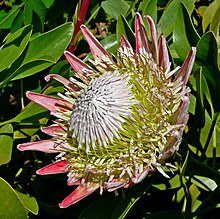Proteales
This article needs additional citations for verification. (November 2015) |
| Proteales Temporal range:
| |
|---|---|

| |
| Protea cynaroides | |
| Scientific classification | |
| Kingdom: | Plantae |
| Clade: | Tracheophytes |
| Clade: | Angiosperms |
| Clade: | Eudicots |
| Order: | Proteales Juss. ex Bercht. & J.Presl[1] |
| Families | |
| Synonyms | |
|
synonymy
| |
Proteales is an order of flowering plants consisting of three (or four) families. The Proteales have been recognized by almost all taxonomists.
The representatives of the Proteales are very different from each other due to their very early divergence. What they have in common is seeds with little or no endosperm. The ovules are often atropic.
The oldest fossils of Proteales are of the nelumbonaceous genus Notocyamus from the Barremian stage of the Early Cretaceous of Brazil.[2]
Families
Within the classification system of
- order Proteales
- family Nelumbonaceae
- family Proteaceae [+ family Platanaceae]
with "+ ..." = optionally separate family (that may be split off from the preceding family).
The APG III system of 2009 followed this same approach, but favored the narrower circumscription of the three families, firmly recognizing three families in Proteales: Nelumbonaceae, Platanaceae, and Proteaceae.[1] The Angiosperm Phylogeny Website, however, suggests the addition of Sabiaceae, which the APG III system did not place in any order in the eudicots, would be sensible.[3]
The APG IV system of 2016 added family Sabiaceae to the order.[4]
Well-known members of the Proteales include the proteas of South Africa, the banksia and macadamia of Australia, the planetree, and the sacred lotus. The origins of the order are clearly ancient, with evidence of diversification in the mid-Cretaceous, roughly over 100 million years ago. Of notable interest is the family's modern distribution; the Proteaceae is predominantly a Southern Hemisphere family, while the Platanaceae and Nelumbonaceae are Northern Hemisphere plants.
Classification
The current
- order Proteales
- family Nelumbonaceae
- family Platanaceae
- family Proteaceae
- family Sabiaceae
Cronquist
The Cronquist system of 1981 recognized such an order and placed it in subclass Rosidae in class Magnoliopsida [=dicotyledons]. It used this circumscription:
- order Proteales
- family Elaeagnaceae
- family Proteaceae
Dahlgren; Thorne; Engler; and Wettstein
The
- order Proteales
- family Proteaceae
References
- ^
- ISSN 2045-2322.
- ^ Stevens, P. F. (2001 onwards). Angiosperm Phylogeny Website. Version 12, July 2012 [and more or less continuously updated since]. Proteales. Accessed online: 9 June 2013.
- .
 Media related to Proteales at Wikimedia Commons
Media related to Proteales at Wikimedia Commons
